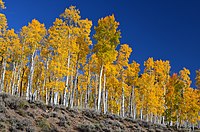
Photo from wikipedia
In this study, a new method was developed to derive a tree survival and diameter growth model from any existing stand-level model, without the need for individual-tree growth data. Predictions… Click to show full abstract
In this study, a new method was developed to derive a tree survival and diameter growth model from any existing stand-level model, without the need for individual-tree growth data. Predictions from the derived tree model are constrained to match number of trees and basal area per ha as outputted by the stand model. The tree models derived from three different stand models were evaluated against a tree model, in both unadjusted and disaggregated forms. For the same stand-level model, the derived tree model outperformed its counterpart, the disaggregated tree model. Furthermore, except for one stand model with poor performance, the tree models derived from the remaining two stand models delivered comparable results to those obtained from the unadjusted tree model. The tree model derived from one stand model even performed slightly better than the unadjusted tree model. This is significant because the coefficients of the unadjusted and disaggregated tree models had to be estimated from tree-level growth data, whereas the derived tree model required no tree growth data at all. The methodology presented in this study should be applicable when there is no ingrowth or recruitment.
Journal Title: Canadian Journal of Forest Research
Year Published: 2021
Link to full text (if available)
Share on Social Media: Sign Up to like & get
recommendations!